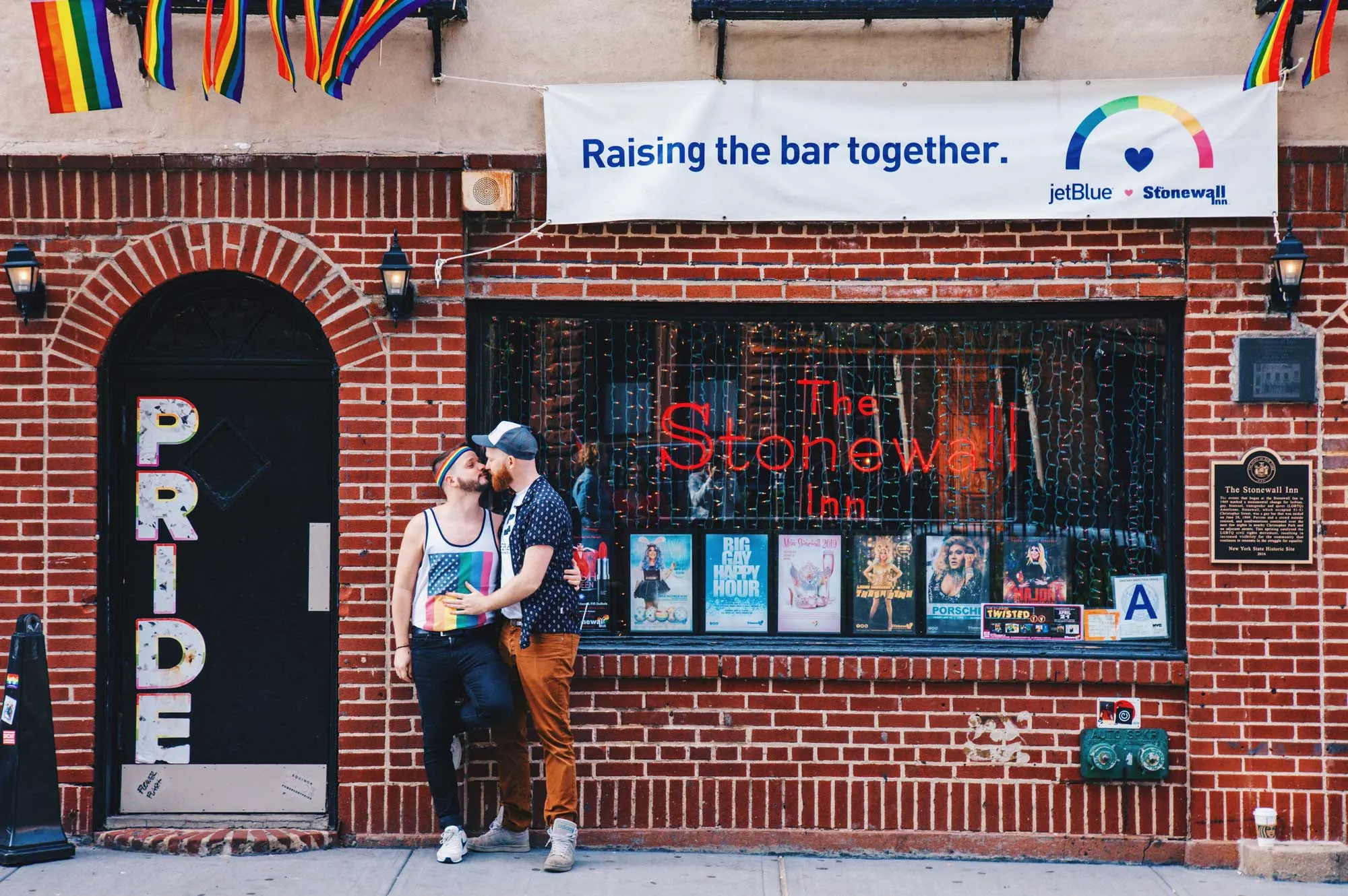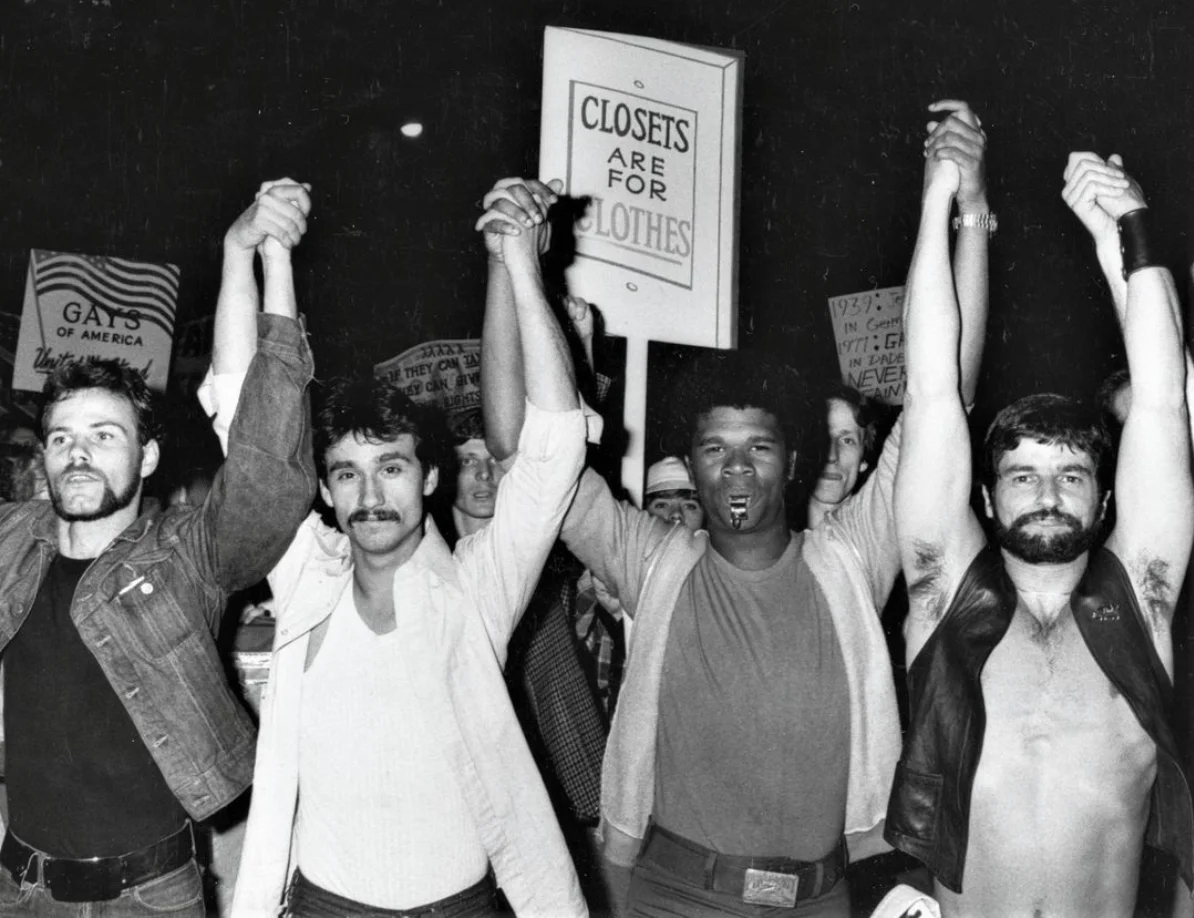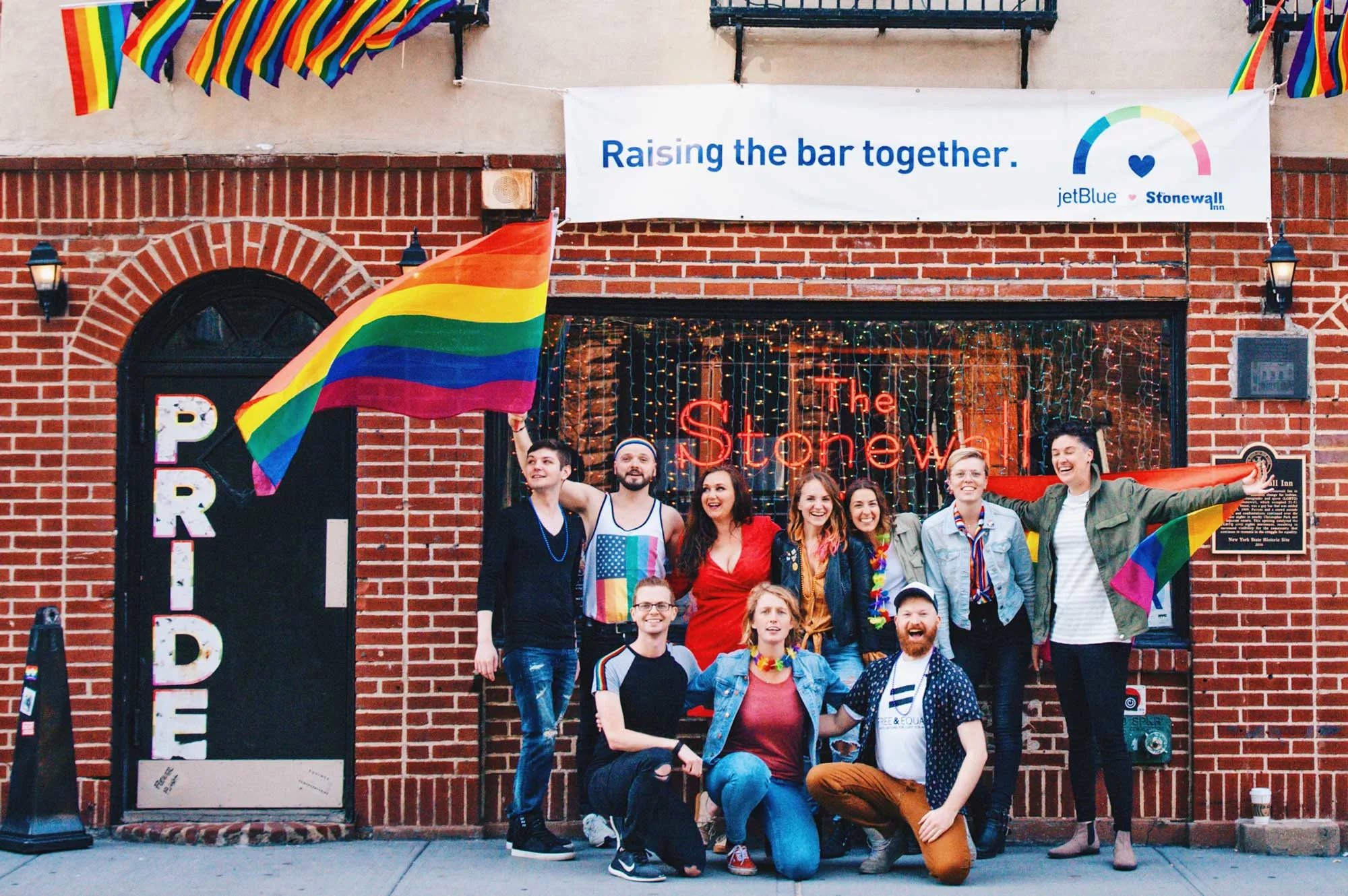Exuberant people celebrating on the street, with colorful costumes, kisses, and holding hands, and above all, the rainbow flag in the wind: This is what it looks like meanwhile when Pride (also known as CSD in Germany) is celebrated worldwide on the occasion of the 50th Anniversary of the Stonewall Inn uprising in New York City in 2019. This is broadly recognized as the beginning of the modern LGBTQ+ rights movement. This article on Couple of Men summarizes the history of CSD, Gay, and LGBTQ+ Pride, raising the questions: Are the Stonewall Riots the beginning of the LGBTQ+ rights movement? And who did throw the first brick (and was it a brick)? Learn how it all started, before and after New York City, how it all continued with the fight of the LGBTQ+ Activists, and how June became Pride Month in the USA – Happy Pride to everyone!
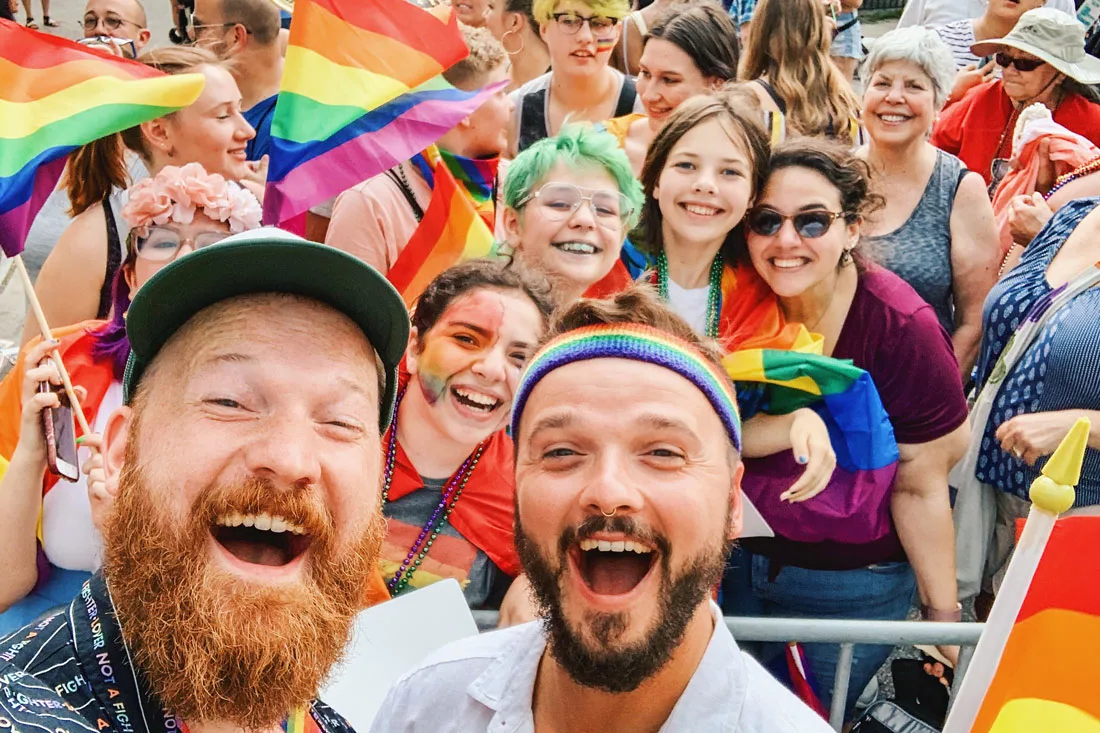
Early LGBTQ+ activism: The beginning of the Homophile Movement
However, it has not always been that easy for the LGBTQ+ community to live out of the closet and celebrate their love, affection, and identity. It was a long and certainly not easy journey for people of different gender identities, gender expressions, sexuality, and lifestyle (although the fight for equality isn’t over yet either). The last days of June in 1969 and the riots at the Stonewall Inn mark for many of the LGBTQ+ community the beginning of the modern LGBTQ+ rights movement and gay history. But is this actually true?
According to historians of the LGBTQ+ community, lesbian, gay, trans, and queer people started to change the awareness of our community already many years before that with the so-called “homophile movement” – a term for the pre-Stonewall gay rights movement. At this time, many gay men preferred the term homophile as it was shifting the focus away from their sexuality, trying to avoid legal issues and political persecution. We have to be aware that at this time in history, homosexuality was listed as an illness worldwide. That was about to change in 1973 when the American Psychiatric Association
“made history by issuing a resolution stating that homosexuality was not a mental illness or sickness.” humanrightscampaign.org
But we still have to go back in time to the late 19th century. It was in 1897 when Magnus Hirschfeld founded his organization in Berlin together with Max Spohr, Franz Josef von Bülow, and Eduard Oberg, the so-called Scientific-Humanitarian Committee; the world’s first gay rights organization. Let’s jump back to the USA to the middle of the 20th century. Already in 1951 in Los Angeles, years before the Stonewall Riots, the American organization Mattachine Foundation was founded by a group of cis-males with the aim to protect and improve the rights of gay men.
Advertisement
KLM Flight Deals
Fly around the world with our gay-friendly partner KLM Royal Dutch Airlines, and its partners Air France and Delta Air Lines in Economy, Premium Comfort and Business Class to LGBTQ+ welcoming destinations worldwide.
Just a couple of years later, in 1953, the Mattachine Society was (re)formed, which managed to spread across the country. Shortly after, in 1955, the American organization Daughters of Bilitis became one of the first lesbian organizations in the United States. But that’s not all. We want to mention the fascinating story of the “Sip-In” at Julius’ Bar. In the early 1960s in New York State, drinking while being gay was considered illegal. Not to mention the fact that getting a liquor license for an openly gay bar was tough. Reasons enough why Mafia-owned bars like the Stonewall Inn still existed in 1969.
The birth of the gay liberation movement and its impact on LGBTQ+ rights
It is essential to know that there was an active LGBTQ+ rights movement before the Stonewall Uprising. And yet, it is essential to understand the importance of the events that took place in June 1969 on Christopher Street in Greenwich Village, New York City. Let’s look at some of the facts we gathered about the historical events around Stonewall Inn that are considered to be the birthplace of the Gay Liberation Front that was responsible for the first pride parades held in commemoration of the Stonewall Riots the year after, in 1970 in Los Angeles, San Francisco, and New York City.
Reading tip: LGBTQ+ Glossary: Understanding Queer Terminology with Respect and Pride
Police raids on gay venues in NYC before the Stonewall uprising
The Stonewall Inn located on Christopher Street in Greenwich Village, New York City, was under the scrutiny of the NYPD with regular raids which went along with the inclusion of the personal details and insults of the queer guests. And while we like to consider the Stonewall Inn to be the only, the best, the most idyllic, or even the most influential gay bar in New York at this time. We are not sure if we had liked to have a drink there. Eyewitnesses commonly describe the Stonewall Inn from 1969 as a dirty, mafia-run bar. So, it remains important to check the facts, even about Gay Pride History.
They used to meet other gay men in several other gay venues in the neighborhood. Nevertheless, these police operations at the local gay and queer venues were usually relatively peaceful, with some arrests of the staff and temporary closures of the bars. On June 27, 1969, however, yet another raid took place at the Stonewall Inn. But something was different. The present gay men, black LGBT, drag, and trans persons refused to leave the scene, ignored referrals, and resisted their arrest.
LGBTQ+ & Gay Activists
These 10 people have made history for the LGBTQ+ Movement. The path in the right direction always starts with a first step, usually taken by courages people who disagree with the given circumstances. The fight of the LGBTQ+ community for equality, tolerance, and acceptance began with tiny steps.
The Stonewall riots of 1969: a turning point in LGBTQ+ history
Eyewitnesses interviewed by the New York Times in 2019 for the celebrations of Stonewall50 are describing the events of the nights of the 27th and 28th of June as a fun, dancing, party-like event on the streets. It turned into a riot that continued intermittently until July 3. Some of them would call it an uprising, even a rebellion from within, rather than a deliberately violent riot against New York police officers. Their resistance against oppression, however, resulted in the worldwide movement to achieve equality for the whole LGBTQ+ community.
Who threw the first brick at Stonewall? LGBTQ+ icons and legends
An essential part of the Stonewall legend seems to be the circumstances that caused someone to throw the first brick. Until today, historians cannot identify whether there have been bricks thrown at the police. Instead, it is more likely that shoes, purses, maybe even shot glasses, and stones have been used as projectiles. Marsha P Johnson, the black trans woman, is often referred to as the initiator of the riots because she threw the first brick. Years after the events, she corrected the storyline by confirming her arrival not as early as 2 am on June 28.
According to Johnson, “…the place was already on fire, and it was a raid already”. And although Sylvia Rivera was undoubtedly among the most important personalities involved in the Stonewall events in 1969, she herself repeatedly corrected the common opinion that she did throw the first Molotov cocktail, if there was ever a Molotov cocktail involved. Regardless of those events, their impact is of the utmost importance for the trans and gay movement to this day.
The first LGBTQ+ demonstrations in Europe and the rise of Pride
The following month, the first Gay March was organized from the Washington Monument to the Stonewall Inn – The gay liberation movement, also known as the gay liberation front, was born. Just one year later, the first Pride Marches took place in Los Angeles, San Francisco, and New York City, followed by other US cities in the following years. And this was just the beginning of the 50-year history of Gay Pride and CSD demonstrations from the USA to Europe and worldwide. The first demonstration of the LGBTQ + community in Europe took place in November 1970 in London, with 70 participants holding a torchlight procession.
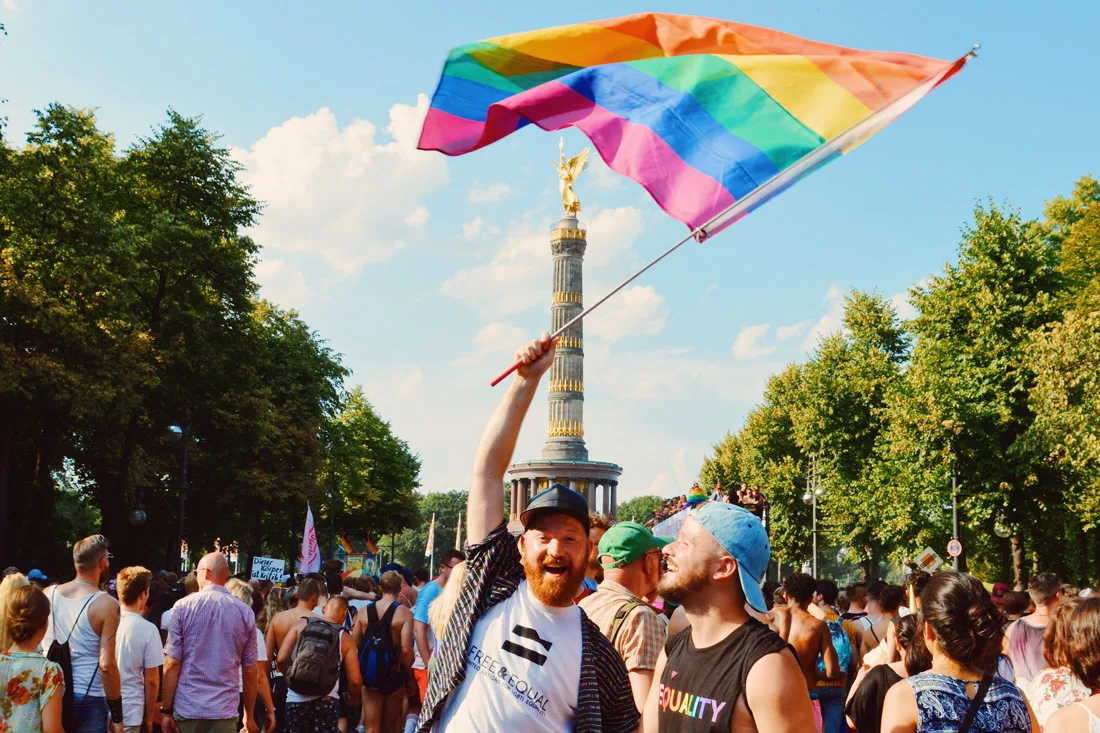
Two years later, the term Gay Pride March was first used when about 2,000 people moved through Oxford Street to Hyde Park. The first demonstration in Germany took place only a few years later on April 29, 1972, in Münster. Later, the first demonstrations of Christopher Street Day followed on June 30, 1979, in the cities of Bremen, Berlin, Cologne, and Stuttgart under the motto Gay Pride. In Switzerland, the first gay pride march took place in June 1978 in Zurich, and in Paris, some years later, in 1981.
EuroPride and WorldPride: global milestones in LGBTQ+ visibility
Meanwhile, Gay Prides are regularly organized in all major cities in Europe and worldwide. Rainbow and LGBTQ+ pride flags are a visible statement for the community as a whole. In 2008, Gay Pride in Amsterdam was voted the best Gay Pride in Europe. The Gay Pride Istanbul is, according to Wikipedia, with 100,000 participants, the largest gay pride march in all of Eastern Europe. Since 1991, the title of EuroPride has been awarded annually to a city. For the first time, the LGBTQ + community celebrated the event in 1992 in London. After Stockholm 2018, EuroPride 2019 in Vienna, and Thessaloniki, Greece in 2024, the next EuroPride will take place in Lisbon in 2025. The World Pride license is awarded at irregular intervals by the InterPride organization. After World Pride in June 2019 in New York City, 2021 in Copenhagen, Denmark, together with Malmö in Sweden in 2022 and 2023 in Sydney, the following two World Pride events will take place in Washington, DC, in 2025 and World Pride in Amsterdam in 2026.
LGBTQ+ Activists of Today
By sharing their experience on their blogs and social media channels, these gay travel bloggers and LGBTQ+ influencers are trying to make not only your vacation planning much easier. They also bring support to (local) LGBTQ+ businesses, being a modern version of past LGBTQ+ activists and part of the recent Gay Pride History. Follow along!
Counter-protests and bans on LGBTQ+ Pride marches through history
As more and more cities and countries took the opportunity to celebrate diversity and tolerance, there were also local conflicts in LGBTQ + community marches. For example, the first queer parade in Brno, Czech Republic, was attacked with tear gas. In Russia, members of the LGBTQ + community are currently still denied the right to demonstrate, and in acts of violence against gays and lesbians, the motive of fear of homosexuality still acts as a deterrent. Counter-demonstrations and protests at Gay Prides are often carried out by conservative religious groups and right-wing extremists.
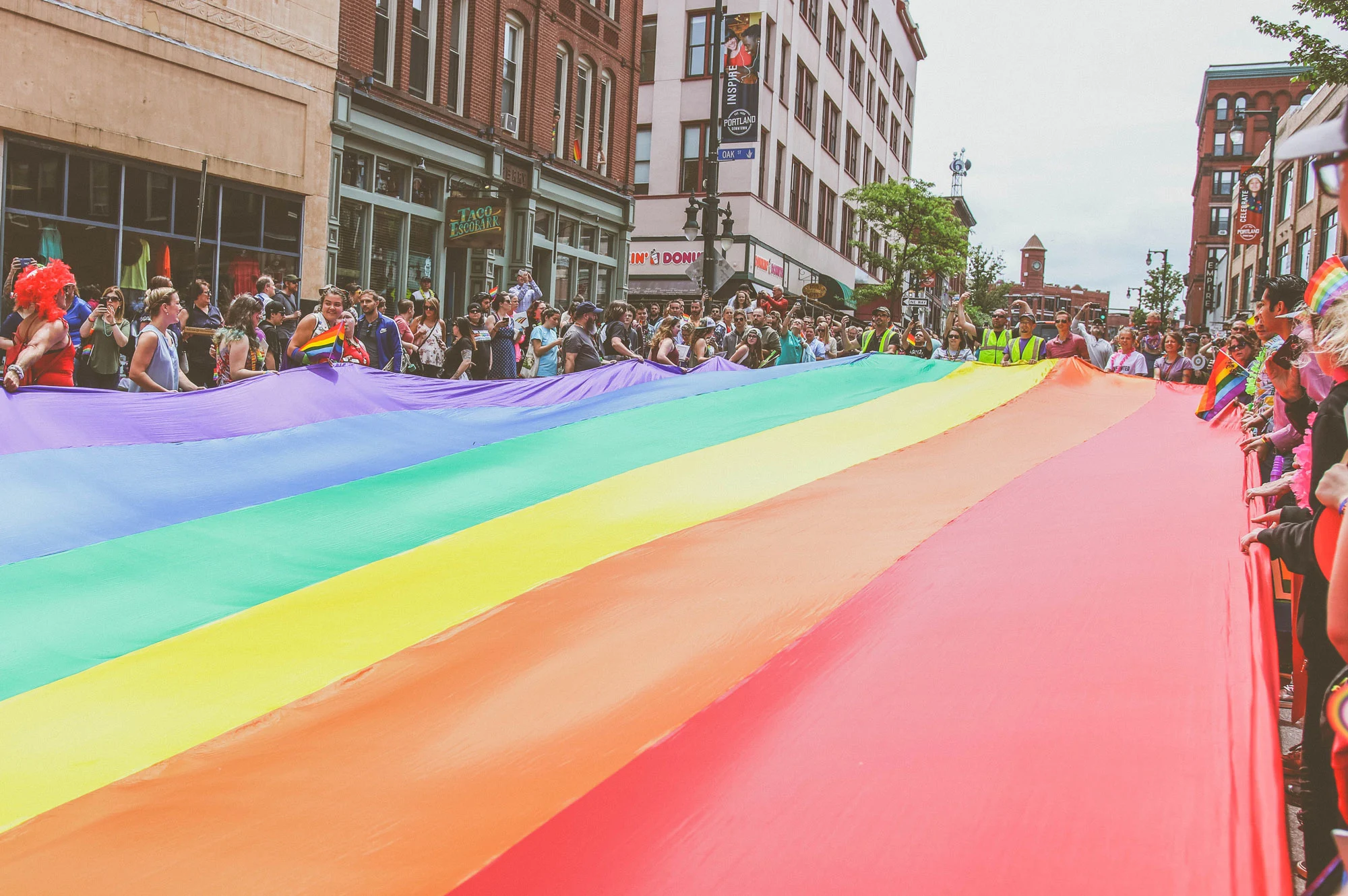
For example, the first Pride in Riga in 2005 could only occur under massive police protection. The following year, the event was banned due to security concerns. The Gay Pride in Tallinn also had to be stopped in 2007 after massive attacks on the demonstrators, and was then banned. In 2017, Karl took part in the then-annual Baltic Pride Gay Pride in Tallinn and was pleased to see significant improvements after the 10-year Pride break in Estonia. Violent riots also occurred at World Pride in Jerusalem in 2005.
Continuing the LGBTQ+ legacy of the Stonewall Inn
Despite and perhaps because of conservative legislation, discrimination, and persecution in far too many countries around the world, Stonewall 50 / World Pride NYC took place in 2020 to signal understanding, acceptance, and tolerance. This is to continue what it did 50 years ago at Stonewall Inn. You can find information on our PRIDE and the LGBTQ+ rights movement page! Happy Pride to the World!

- Gay Pride Parades & CSD in Germany in an overview
- Overview: Our best Gay Pride Trips around the world
- Tested: All Gay- and LGBTQ+ friendly Hotels worldwide
- Top List: Our Top 5 Gay Pride Events from NYC to Vienna
Info Source: Blick | TheStoneWallInn | Wikipedia | Theodysseyonline | HRC | Metrosource
Do you want to know more about our gay travel adventures and LGBTQ+ news from around the world? Follow us on Instagram, Threads, YouTube, and Facebook!

